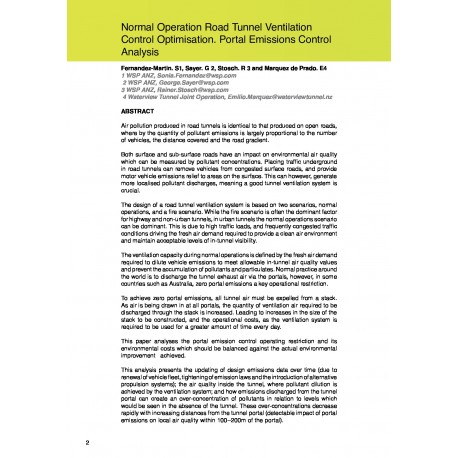Cart
0
0
No document
0,00 €
Total
Document successfully added to your shopping cart
Quantity
Total
There are 0 items in your cart.
There is 1 item in your cart.
Total documents
Total shipping
To be determined
Total
Search & filter
Search for a publication
Search & filter
Normal Operation Road Tunnel Ventilation Control Optimisation. Portal Emissions Control Analysis
2643_normal_operation_road_tunne
S. Fernandez-Martin / G. Sayer / R. Stosch / E. M. de Prado
Air pollution produced in road tunnels is identical to that produced on open roads, where by the quantity of pollutant emissions is largely proportional to the number of vehicles, the distance covered and the road gradient.Both surface and sub-surface roads have an impact on environmental air quality which can be measured by pollutant concentrations. Placing traffic underground in road tunnels can remove vehicles from congested surface roads, and provide motor vehicle emissions relief to areas on the surface. This can however, generate more localised pollutant discharges, meaning a good tunnel ventilation system is crucial.The design of a road tunnel ventilation system is based on two scenarios, normal operations, and a fire scenario. While the fire scenario is often the dominant factor for highway and non-urban tunnels, in urban tunnels the normal operations scenario can be dominant. This is due to high traffic loads, and frequently congested traffic conditions driving the fresh air demand required to provide a clean air environment and maintain acceptable levels of in-tunnel visibility. The ventilation capacity during normal operations is defined by the fresh air demand required to dilute vehicle emissions to meet allowable in-tunnel air quality values and prevent the accumulation of pollutants and particulates. Normal practice around the world is to discharge the tunnel exhaust air via the portals, however, in some countries such as Australia, zero portal emissions a key operational restriction. To achieve zero portal emissions, all tunnel air must be expelled from a stack. As air is being drawn in at all portals, the quantity of ventilation air required to be discharged through the stack is increased. Leading to increases in the size of the stack to be constructed, and the operational costs, as the ventilation system is required to be used for a greater amount of time every day.This paper analyses the portal emission control operating restriction and its environmental costs which should be balanced against the actual environmental improvement achieved. This analysis presents the updating of design emissions data over time (due to renewal of vehicle fleet, tightening of emission laws and the introduction of alternative propulsion systems); the air quality inside the tunnel, where pollutant dilution is achieved by the ventilation system; and how emissions discharged from the tunnel portal can create an over-concentration of pollutants in relation to levels which would be seen in the absence of the tunnel. These over-concentrations decrease rapidly with increasing distances from the tunnel portal (detectable impact of portal emissions on local air quality within 100–200m of the portal).




